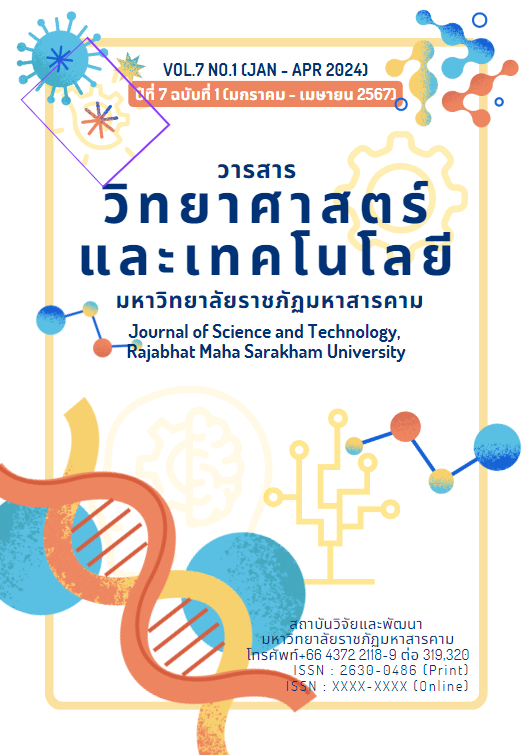Drying Kinetics and Modelling of Butterfly Pea Flower with Hot Air
Keywords:
Butterfly pea flowers, Hot air drying, Specific energy consumption, Mathematical ModelingAbstract
This research investigated the chemical kinetics, drying rate, specific energy consumption, and mathematical modeling of butterfly pea flower drying. The conditions of the drying tests include three levels of hot air temperature (50, 60, and 70 °C) and two levels of air velocity (1 and 2 m/s). The results showed that hot air temperature and air velocity affect the drying of butterfly pea flowers. The drying time decreased with increasing temperature and velocity. The average drying rate was 62 % at 60 °C and increased to 84% at 70 °C. The best performance for the specific energy value was drying butterfly pea flowers at 70 °C hot air temperature with 2 m/s air velocity. Hence, the value equals 16 % compared to the highest specific energy value of drying. The drying rate of butterfly pea flowers increased when the temperature and velocity increased. The results of the mathematical model prediction of the butterfly pea flower drying showed that the Wang and Singh equations were the best predictors of drying results, with R2 values between 0.987970239 to 0.994963057 and χ2 values between 0.006830940 to 0.009775177.
References
Azmi, S.K. & Ibrahim, D. (2020). Mathematical Modeling and Drying Characteristics Investigation of Black Mulberry Dried by Microwave Method. Internation Journal of Fruit Science, 20, 1222-1233.
Akpinar, E.K. (2008). Mathematical modelling and experimental investigation on sun and solar drying of white mulberry. Journal of Mechanical science and technology, 22, 1544-1553.
Akpinar, E.K. & Bicer, Y. (2008). Mathematical modelling of thin layer drying process of long green pepper in solar dryer and under open sun. Journal of Energy Conversion and Management, 88(49), 1367–1375.
Akpainar, E.K. et al. (2003). Thin layer drying of red pepper. Journal of Food Engineering, 59(1), 99-104.
Diamante, L.M. et al. (2010). A new mathematical model for thin layer drying of fruits. International Journal of Food Science and Technology, 45 (9), 1956-1962.
Doymaz, I. (2007). The kinetics of forced convective air-drying of pumpkin slices. Journal of Food Engineering, 79, 243-248.
Doymaz, I. (2005). Sun drying of figs: an experimental study. Journal of Food Engineering, 71, 403-407.
Havananda, T. & Leungwliai, K.. (2019). Effect of Harvest Time and Season on Antioxidant Activity, Anthocyanin and Total Phenolic Content of Butterfly Pea Flower. King Mongkut's Agricultural Journal,37 (4), 655-661.
Jalal, D. et al. (2018). Multi-stage continuous and intermittent microwave drying of quince fruit coupled with osmotic dehydration and low temperature hot air drying. Journal of Innovative Food Science and Emerging Technologies, 45, 132-151.
Kashaninejad, M. et al. (2007). Thin-layer drying characteristics and modeling of pistachio nuts. Journal of Food Engineering, 78, 98–108.
Kar, A., & Gupta, D.K. (2003). Air drying of osmosed button mushroom. Journal of Food Science and Technology, 40(1), 23-27.
Luampon, R. (2018). Thin Layer Drying Model of Carrot Using a Heat Pump Vacuum Dryer. Journal of KMUTNB, 28, 147-155.
Midilli, A., Kucuk, H., & Yapar, Z. (2002). A new model for single- layer drying. Journal of Drying Technology, 20(7), 1503-1513.
Nadee, A. et al. (2012). Drying Kinetics of Pandanus Leaf by Infrared Radiation Combine Hot Air and Hot Air. Burapha Science Journal, 17, 86-94.
Togrul, I.T., & Pehlivan, D. (2002). Mathematical modeling of soar drying of apricots in thin layers. Journal of Food Engineering, 55, 209-216.
Torpol, S. & Uengkimbuan, N. (2012). A Study on Drying Kinetics of Peppers Using Hot Air Dryers. Agricultural Science Journal, 43, 107-110.
Tumthong, P. et al. (2011). Study on Drying Behavior of Tilapia nilotica Using Hot Air. Agricultural Science Journal, 42, 573-576.
Saniso,*E. & Kasa, M. (2009). Thin Layer Drying of Garcinia atroviridis Slice : Drying Kinetic Model and Diffusion Coefficient. Burapha Science Journal, 14, 26-33.
Wang, C.Y., & Singh R.P. (1978). A single layer drying equation for rough rice. ASAE paper. No. 78-3001, St Joseph, Michigan.
Zhao, R. & Gao, T., (2016). Research Progress of Hot Air Drying Technology for Fruits and Vegetables. Journal of Food Science and Technology .10(3): 160-166.



